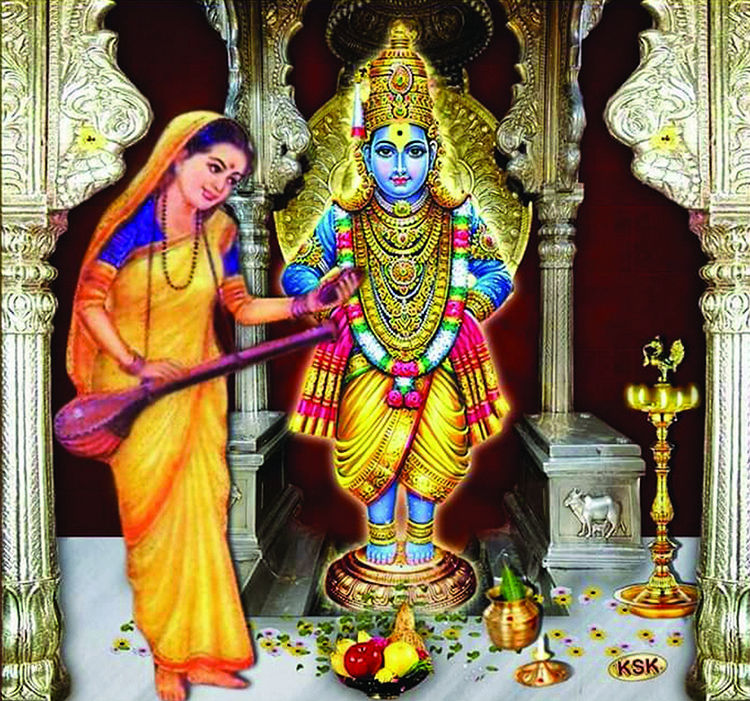
Kanhopatra was the very beautiful daughter of the courtesan Shyama. They lived in Mangalvedhe, not far from Pandharpur in the 15 century. Shyama taught her daughter to sing and dance and hoped to make ample money out of her performances and services. Though forced into this fallen profession, Kanhopatra rebelled against it and vowed not to accept any suitor unless he was equal in beauty to herself.
One day a group of varkaris passed her house on their way to Pandharpur, singing Vitthala’s praises. Hearing about Vitthala’s beautiful, blissful image in the temple, and learning that He was called Patita Pavan, the ‘purifier of the fallen’, she developed a great longing for His darshan. She soon visited Pandharpur and when she saw the divine image, she was so filled with admiration and love, that she decided to stay in Pandhari and surrender her life at the Lord’s feet. Most of the depictions of Kanhopatra show her holding a veena near the image of Vitthala; so it is believed that she sang abhangs and did bhajan in and around the temple.
Whereas other women bhaktas, whether married or unmarried, were somehow integrated into a family, Kanhopatra was all by herself with Vitthala as her protector. Upon hearing about Kanhopatra’s great beauty, the king of Bedar of the Bahamani dynasty requested her to come to his palace as a concubine. When she refused, he sent messengers to take her by force. She took refuge in the temple and pleaded with Vitthala to save her, and in this precarious situation she died right there before the sanctum.
Did she merge into Vitthala? Did she commit suicide? Did her heart stop over-powered by emotion? One can only guess. Her body was placed at Vitthala’s feet and hurriedly she was buried right there within the temple precincts. On this very place from beneath the stone slabs of the temple, unfed by water, a strange tree sprang up – the Tree of Kanhopatra worshipped by the pilgrims. She is the only sant who has her samadhi within the temple of Vithoba.
There are about 25 extant abhangs sung by Kanhopatra. Many of her abhangs refer to her debased social status. She calls herself impure, fallen, unworthy of God’s grace; but she reminds Vitthala that He has liberated many great sinners. There is a certain physical vulnerability coming through in many of her songs, a desperate cry for protection, feeling her body in danger which the other women sants don’t show; Muktabai for example never mentions her body as a woman! This body consciousness must have arisen from her hated profession of being the object of desire of men.
She says patita tu pavana, mhanavisi Narayana, “You are called purifier of the fallen, Narayana, keep your promise, stand up for your Name! My caste is not clean, neither my faith, I have a vile behaviour and character! Not even your name is on my lips – Kanhopatra seeks refuge at your feet!”
In varma vairiyache hati,deu nako Shripati she pleads “Don’t give my inner essence into the hands of the predators, Shripati! You are the Lord of those who have nobody, you are merciful, compassionate to the low – all the Vedas and shastras proclaim that! Your feet carry that label! Now stand by it and your devotee, don’t abandon me begs your dasi Kanhopatra.” Giving instances of how God lowered himself for the sake of his bhaktas, she calls on Him to do likewise with her.
In a beautiful abhang she eventually describes Vitthala’s darshan janmantariche sukrita aji phalasi ale, “The good deeds of all my past lives have borne fruit today – I have seen Vitthala’s feet! Blessed my good fortune that my eyes beheld today –I have seen Vitthala’s feet! Blessed my feet walking this sacred path to Pandhari – and I saw Vitthala’s feet! By coming here my body became blessed hence I saw Vitthala’s feet! Kanhopatra would gladly take birth again and again if she could see in every life the feet of Vitthala!”
The following lines are said to be Sant Kanhopatra’s final verses before leaving her body. nako devaraya anta ata pahu, “Please don’t test me! Already my breath is leaving me! The doe’s little fawn is caught by a tiger, this is just how I’m feeling, Lord! Without you there is no place to hold on to in all the three worlds, Mother Vithabai run fast! Come! I am hopeless. Take Kanhopatra into your heart!”
Her desperate last appeal leaves us pensive that the only option to transcend her female body as an object of desire was by giving it up. It reinforces the concept that the loving relation between bhakta and God is eternal, birth after birth or as Namdev Maharaj vows deha javo athava raho Pandurangi dridha bhavo, “No matter if the body goes or remains – my love for Vitthala is firm!”
Kanhopatra’s tree in the temple, venerated for centuries, also given up its life in 2015. No new leaves are sprouting anymore, only the slant overhanging stem remains. Is it due to the torture the pilgrims inflicted on the tree over the years in the name of bhakti by plucking off pieces of this ‘blessed bark’ to take home, or is it Vitthala’s lila?